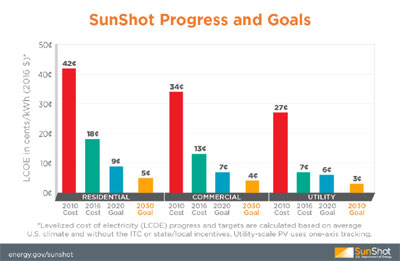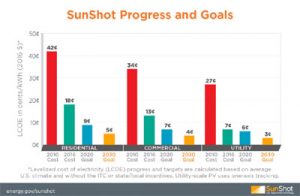With so much at stake environmentally, the Obama administration is scrambling to make as much progress as they can before Trump takes over.
No Arctic Drilling
No more leases for oil drilling will be allowed in the Arctic Ocean, says the Interior Department’s newly released five year plan, but one lease would be available in Alaska’s Cook Inlet and 10 in the Gulf of Mexico, amounting to millions of acres. Shame on them: even facing a full-on GOP threat, they missed the opportunity to ban all Arctic drilling permanently and close the Gulf to more huge leases.
Even curtailing drilling over the next five years in this way leaves the oil industry holding over 70% of economically developable leases, says Abigail Ross Hopper, director of Interior’s Bureau of Ocean Energy Management.
If Trump selects someone like – believe it or not – drill-baby-drill Sarah Palin to head Interior, she would have to go through years of hearings and comment periods to push through a new 5-year plan. And if gas prices remain low, companies won’t be tempted to drill anyway.
Of course, Speaker of the House Paul Ryan vows to overturn the 5-year plan and he’s already got a lovely sounding name for an agenda that would turn the clock back to the good ole fossil days. “Our Better Way agenda outlines a plan to unleash our energy potential and create American jobs. That’s why we will work to overturn this plan, and to open up the Arctic and other offshore areas for development.”
That’s why 34 leading scientists told Obama, he needs to permanently protect the Arctic.”Pressures are mounting to fish, mine, and tour the Arctic, but fossil fuels are the resources most coveted,” the letter says. “First, the hypersensitivity of Arctic ecosystems, combined with our obvious inability to respond to significant spills under Arctic conditions, means that we are taking risks we cannot manage; we are essentially crossing our fingers that we will cause no severe, adverse events such as the Exxon Valdez or Deepwater Horizon oil spills. That is not the approach of a country committed to sustainability …”
Methane Emissions Regulations
Interior’s “Methane and Waste Prevention Rule,” – finalizes regulations on oil and gas operations on federal and Native American lands. The goal is to reduce methane emissions – so high right now that natural gas has the same toxic emissions as coal – and to provide a fair return to taxpayers when they drill on our public lands.
Because of careless industry practices such as leaks and flaring, the amount of natural gas lost between 2009-2015 could have supplied over 6 million households for a year, notes Interior. The rule is expected to reduce methane emissions by as much as 35%.
The common sense rule, which is phased in over time, requires producers to cut flaring 50% using widely available – and affordable – technologies; periodically inspect operations for leaks; and replace outdated equipment that vents large quantities of gas into the air. It also ensures the public is paid fairly for industry use of public land by finally giving the Bureau of Land Management (BLM) flexibility on setting royalty rates. And they can charge royalties for gas that’s flared into the atmosphere.
BLM developed the final rule after holding hearings for two years and reviewing hundreds of thousands of comments.
You’d think the industry would want to profit from the gas it drills rather than waste it. “America’s natural gas is a resource, not a waste product, and it’s time we start treating it that way,” says BLM Director Kornze. “This common-sense rule will save enough gas to supply every household in Dallas and Salt Lake City combined – every year.”
11% of America’s gas supply, and 5% of oil comes from our public lands. There are 96,000 wells on our lands!
“The Republican majority in Congress will not let this rule stand. We will work with President-elect Trump to revoke this rule either administratively or through the use of the Congressional Review Act,” says Senator John Barrasso (R-WY).
Oil trade groups have already filed lawsuits claiming Interior doesn’t have the authority to regulate methane. A Wyoming judge agreed with them and Interior appealed. Under a Republican, that appeal would simply be dropped. Trade groups are also suing the EPA for its methane regulations.
‘Smart From the Start’ Renewable Energy Development on Public Lands
Another announcement from Interior finalizes how solar and wind development can take place on public lands. It sets aside 700,000 acres by formalizing “Smart from the Start“, where landscape scale research identifies the best sites in advance and then streamlines the permitting process there. The best sites have easy access to infrastructure and avoid sensitive environmental areas. The rule also allows BLM to charge fair market value for leasing the land.
Read our article, Little Known Fact: Renewable Energy Companies Pay Way More Than Fossil Firms to Lease Public Land.
Raises the Bar for SunShot Program
The goal of this program, begun in 2011, is to make solar PV cost-competitive with fossil fuels without subsidies by 2020. After five years, utility-scale solar is 90% of the way there, and commercial and residential, 70%.
So, DOE raised the bar. The new goal is to reduce the cost of solar electricity by another 50% by 2030.
Right now, it costs $0.07 per kilowatt-hour (kWh) for utility-scale solar – just a penny more than the 2020 goal. Under the new targets, utility-scale solar electricity would cost $0.03/ kWH; $0.04/ kWh for commercial PV; and $0.05/ kWh for residential PV. In sunnier regions, the cost would be even lower.
Another very sucessful DOE program is Better Buildings, which reduces energy consumption of buildings across the country. A new accelerator, “Better Buildings Zero Energy Districts,” in partnership with the National League of Cities, will push that process forward by creating Zero Energy Districts.
The idea is to form districts of buildings where the amount of energy delivered them is equal or less than the renewable energy they can export.
The first districts will be:
- Denver, Colorado: National Western Center project and Sun Valley Ecodistrict
- Huntington Beach, California: Advanced Energy Communities
- Fresno, California: Fresno Energy Performance District
- St. Paul, Minnesota: Ford Twin Cities Assembly plant Redevelopment Project
- Buffalo, New York: Western New York Manufacturing ZNE District
While it will be a complicated, long process to reverse final regulations, that’s not the case for rules issued within 60 days of a new Congress. They can be repealed all at once – all Congress has to do is issue a resolution disapproving of them. Under the Congressional Review Act, Congress could possibly repeal final regulations issued since May via a simple majority vote.
They could go even further by passing legislation that permanently bars EPA and Interior from ever regulating greenhouse gases. That would automatically kill the Clean Power Plan, for example, and would require future legislation to reverse it. Read more about their options.
Here are nine environmental rules that likely will be repealed:
http://insideclimatenews.org/news/22112016/donald-trump-obama-environmental-regulations-deregulation-epa


Solar isn’t anywhere near 70% to parity with traditional generation, and the cost per kWh figures include ITC and state tax incentives in most cases….stop distorting the facts!
The arctic decision is weak–most of the Arctic is Canadian.
Carbon Man: according to the Department of Energy, utility-scale solar costs 7 cents per kilowatt hour, just a penny more than fossil fuels at 6 cents. And this is without subsidies. Don’t forget, fossil fuels are subsidized way more than solar, it’s just under the radar.